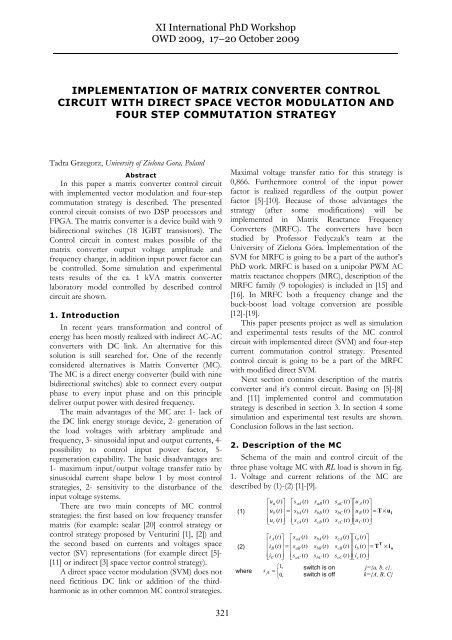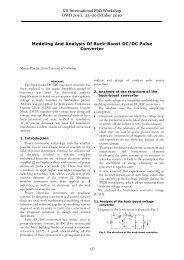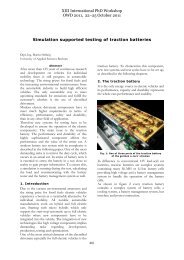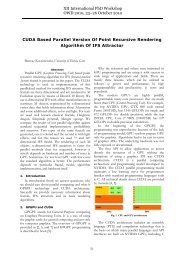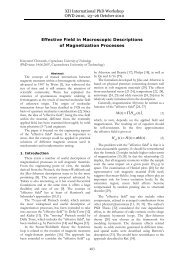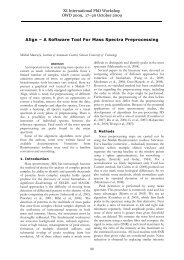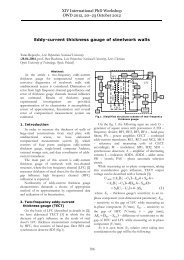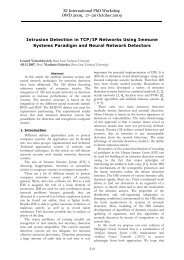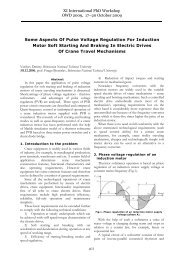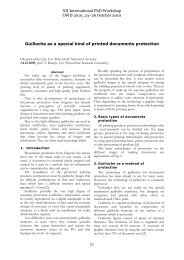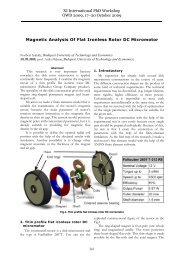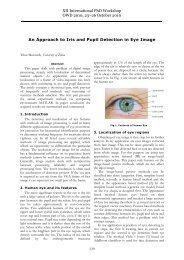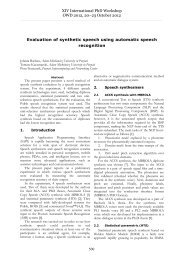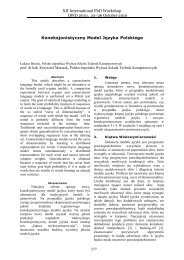IMPLEMENTATION OF MATRIX CONVERTER CONTROL CIRCUIT ...
IMPLEMENTATION OF MATRIX CONVERTER CONTROL CIRCUIT ...
IMPLEMENTATION OF MATRIX CONVERTER CONTROL CIRCUIT ...
Create successful ePaper yourself
Turn your PDF publications into a flip-book with our unique Google optimized e-Paper software.
<strong>IMPLEMENTATION</strong> <strong>OF</strong> <strong>MATRIX</strong> <strong>CONVERTER</strong> <strong>CONTROL</strong><br />
<strong>CIRCUIT</strong> WITH DIRECT SPACE VECTOR MODULATION AND<br />
FOUR STEP COMMUTATION STRATEGY<br />
Tadra Grzegorz, University of Zielona Gora, Poland<br />
Abstract<br />
In this paper a matrix converter control circuit<br />
with implemented vector modulation and four-step<br />
commutation strategy is described. The presented<br />
control circuit consists of two DSP processors and<br />
FPGA. The matrix converter is a device build with 9<br />
bidirectional switches (18 IGBT transistors). The<br />
Control circuit in contest makes possible of the<br />
matrix converter output voltage amplitude and<br />
frequency change, in addition input power factor can<br />
be controlled. Some simulation and experimental<br />
tests results of the ca. 1 kVA matrix converter<br />
laboratory model controlled by described control<br />
circuit are shown.<br />
1. Introduction<br />
In recent years transformation and control of<br />
energy has been mostly realized with indirect AC-AC<br />
converters with DC link. An alternative for this<br />
solution is still searched for. One of the recently<br />
considered alternatives is Matrix Converter (MC).<br />
The MC is a direct energy converter (build with nine<br />
bidirectional switches) able to connect every output<br />
phase to every input phase and on this principle<br />
deliver output power with desired frequency.<br />
The main advantages of the MC are: 1- lack of<br />
the DC link energy storage device, 2- generation of<br />
the load voltages with arbitrary amplitude and<br />
frequency, 3- sinusoidal input and output currents, 4-<br />
possibility to control input power factor, 5-<br />
regeneration capability. The basic disadvantages are:<br />
1- maximum input/output voltage transfer ratio by<br />
sinusoidal current shape below 1 by most control<br />
strategies, 2- sensitivity to the disturbance of the<br />
input voltage systems.<br />
There are two main concepts of MC control<br />
strategies: the first based on low frequency transfer<br />
matrix (for example: scalar [20] control strategy or<br />
control strategy proposed by Venturini [1], [2]) and<br />
the second based on currents and voltages space<br />
vector (SV) representations (for example direct [5]-<br />
[11] or indirect [3] space vector control strategy).<br />
A direct space vector modulation (SVM) does not<br />
need fictitious DC link or addition of the third-<br />
harmonic as in other common MC control strategies.<br />
XI International PhD Workshop<br />
OWD 2009, 17–20 October 2009<br />
321<br />
Maximal voltage transfer ratio for this strategy is<br />
0,866. Furthermore control of the input power<br />
factor is realized regardless of the output power<br />
factor [5]-[10]. Because of those advantages the<br />
strategy (after some modifications) will be<br />
implemented in Matrix Reactance Frequency<br />
Converters (MRFC). The converters have been<br />
studied by Professor Fedyczak’s team at the<br />
University of Zielona Góra. Implementation of the<br />
SVM for MRFC is going to be a part of the author’s<br />
PhD work. MRFC is based on a unipolar PWM AC<br />
matrix reactance choppers (MRC), description of the<br />
MRFC family (9 topologies) is included in [15] and<br />
[16]. In MRFC both a frequency change and the<br />
buck-boost load voltage conversion are possible<br />
[12]-[19].<br />
This paper presents project as well as simulation<br />
and experimental tests results of the MC control<br />
circuit with implemented direct (SVM) and four-step<br />
current commutation control strategy. Presented<br />
control circuit is going to be a part of the MRFC<br />
with modified direct SVM.<br />
Next section contains description of the matrix<br />
converter and it’s control circuit. Basing on [5]-[8]<br />
and [11] implemented control and commutation<br />
strategy is described in section 3. In section 4 some<br />
simulation and experimental test results are shown.<br />
Conclusion follows in the last section.<br />
2. Description of the MC<br />
Schema of the main and control circuit of the<br />
three phase voltage MC with RL load is shown in fig.<br />
1. Voltage and current relations of the MC are<br />
described by (1)-(2) [1]-[9].<br />
⎡ua<br />
( t)<br />
⎤ ⎡saA<br />
( t)<br />
saB<br />
( t)<br />
saC<br />
( t)<br />
⎤⎡u<br />
A ( t)<br />
⎤<br />
⎢ ⎥ ⎢<br />
⎥⎢<br />
⎥<br />
(1) ⎢<br />
ub<br />
( t)<br />
⎥<br />
=<br />
⎢<br />
sbA<br />
( t)<br />
sbB<br />
( t)<br />
sbC<br />
( t)<br />
⎥⎢<br />
u B ( t)<br />
⎥<br />
= T × ui<br />
⎢⎣<br />
uc<br />
( t)<br />
⎥⎦<br />
⎢⎣<br />
scA<br />
( t)<br />
scB<br />
( t)<br />
scC<br />
( t)<br />
⎥⎦<br />
⎢⎣<br />
uC<br />
( t)<br />
⎥⎦<br />
⎡iA<br />
( t)<br />
⎤ ⎡s<br />
aA ( t)<br />
sbA<br />
( t)<br />
scA<br />
( t)<br />
⎤⎡ia<br />
( t)<br />
⎤<br />
⎢ ⎥ ⎢<br />
⎥⎢<br />
⎥ T<br />
(2) ⎢<br />
iB<br />
( t)<br />
⎥<br />
=<br />
⎢<br />
saB<br />
( t)<br />
sbB<br />
( t)<br />
scB<br />
( t)<br />
⎥⎢<br />
ib<br />
( t)<br />
⎥<br />
= T × i o<br />
⎢⎣<br />
iC<br />
( t)<br />
⎥⎦<br />
⎢⎣<br />
saC<br />
( t)<br />
sbC<br />
( t)<br />
scC<br />
( t)<br />
⎥⎦<br />
⎢⎣<br />
ic<br />
( t)<br />
⎥⎦<br />
where<br />
s jk<br />
⎧1,<br />
= ⎨<br />
⎩0,<br />
switch is on<br />
switch is off<br />
j={a, b, c},<br />
k={A, B, C}
Fig. 1. Three- phase Matrix Converter<br />
MC can theoretically assume 512 (2 9) switching<br />
configurations (SC) but because of commutation<br />
lows there are only 27 SC permitted among which 21<br />
SC (18 active and 3 zero), are engaged in direct SVM<br />
[3]-[8]. Geometrical interpretations of those 21 SC<br />
are shown in fig. 3.<br />
Fig. 2. Geometrical interpretation of the 21 switch<br />
configurations engaged in direct SVM.<br />
Using transformation (3) input and output voltages<br />
and currents of the MC can be represented as space<br />
vectors.<br />
(3)<br />
2 j(<br />
2π<br />
/ 3)<br />
j(<br />
4π<br />
/ 3)<br />
x = ( x1<br />
+ x2e<br />
+ x3e<br />
3<br />
Where x 1<br />
, x 2<br />
, x 3<br />
– instantaneous values of the transformed<br />
signals.<br />
The geometrical interpretations of the space-<br />
vector representations of the line to neutral load<br />
voltages (uaN, ubN, ucN) and input line currents (iA, iB,<br />
iC), created for all active and zero SC (fig. 2)<br />
according to (3) are shown in fig.3. Furthermore<br />
numbers of the sectors (Si, So) between those<br />
vectors are introduced [7].<br />
Because of MC complexity its control and<br />
commutation strategy is complicated and demands<br />
advanced hardware solutions. That is why presented<br />
control circuit consists of two DSP processors<br />
(ADSP 21368), three A/D converters and a FPGA<br />
circuit (fig. 1). Basic specifications data for those<br />
components are collected in table 1. Using this<br />
control circuit instantaneous space- vector<br />
representations of the source currents are calculated.<br />
)<br />
322<br />
Based on those calculations proper switching<br />
sequence can be found to form desired load voltage<br />
vector. This process will be described in detail in the<br />
next section.<br />
Fig. 3. Space vector representations for, a) load line to<br />
neutral voltages (uaN, ubN, ucN), b) input line currents<br />
jα<br />
0 u 0 = e<br />
- exemplary line to neutral load voltages<br />
jβ<br />
i i<br />
vector position, i = e<br />
- exemplary line source currents<br />
vector position,, So- sector No. for u0, Si- sector No. for ii<br />
Table. 1 Specifications data for control circuit<br />
components<br />
Component Specification<br />
Processor DSP<br />
(ADSP-21368)<br />
ALS-3G-2368<br />
PCI<br />
FPGA (XS3S200)<br />
Converters<br />
A/D – D/A<br />
ALS-3G-<br />
ACA1812-1<br />
Manufactured by Analog Devices;<br />
clock speed 400 MHz; 1600 MFLOPS;<br />
2 Mbit SRAM; 6 Mbit ROM<br />
Manufactured by Xilnix; clock speed<br />
10 MHz; programable system gates:<br />
200000, 216kbajtów RAM<br />
18 bit A/D converter; convertion speed<br />
up to 570 kSps, input voltage range: +/-<br />
2,48V<br />
3. Control and commutation strategy<br />
Functional schema of the implemented control<br />
and commutation strategy and tasks division for<br />
control circuit components are shown in fig. 4.<br />
Because of MC source currents distortion their space<br />
vector representation ii is determined basing on<br />
measured source phase voltages. The way in with
source currents vector position is define, based upon<br />
source voltages vector position (calculated according<br />
to (3)) is shown in fig. 6b. Load voltages space<br />
vector uo, with desired amplitude and angular<br />
velocity ωout, is also calculated according to (3). In<br />
the next step according to fig. 3 previously calculated<br />
ii and uo positions allows sector numbers S0, Si and<br />
phase angels α’0, β’i to be identified. It has to be<br />
mentioned that phase angels α’0, β’i are defined with<br />
respect to bisecting line of suitable sector, limited<br />
according to (4) and differ then α0, βi (fig. 3, fig. 6)<br />
[7].<br />
(4) − π 6 < α'0<br />
< π 6 π 6 < β ' < π 6<br />
ALS-3G-2368 PCI<br />
21 SC.<br />
(fig. 2)<br />
saA<br />
ia ib ic<br />
β’i<br />
IDENTIFICATION<br />
(4)<br />
ON-TIME<br />
RATIOS<br />
CALCULATION<br />
(5)-(8)<br />
VECTOR<br />
SELECTION<br />
(tab. 1, tab. 2)<br />
saB saC<br />
SIGNAL CHANGE<br />
DETECTION<br />
SWITCH SEQUENCE<br />
SELECTION<br />
Tseq<br />
TRANSISTOR<br />
<strong>CONTROL</strong> SIGNALS<br />
So IDENTIFICATION (rys. 3b)<br />
α’0<br />
IDENTIFICATION<br />
(4)<br />
Si IDENTIFICATION (Rys. 3a)<br />
SWITCH- ON TIMES<br />
CALCULATION (9),(10)<br />
(rys. 9)<br />
sbA sbB sbC<br />
SWITCH SEQUENCE<br />
SELECTION<br />
− i<br />
uB<br />
uC<br />
CALCULATION <strong>OF</strong> THE SOURCE CURRENTS<br />
VECTOR REPRESENTATION (3)<br />
SWITCHING PATTERN<br />
(11), (12), (fig. 6)<br />
<strong>CONTROL</strong> SIGNALS FOR BIDIRECTIONAL<br />
SWITCHES<br />
SIGNAL CHANGE<br />
DETECTION<br />
(rys. 9)<br />
TRANSISTOR<br />
<strong>CONTROL</strong> SIGNALS<br />
scA scB scC<br />
(rys. 9)<br />
SIGNAL CHANGE<br />
DETECTION<br />
SWITCH SEQUENCE<br />
SELECTION<br />
TRANSISTOR<br />
<strong>CONTROL</strong> SIGNALS<br />
TaA1 TaA2 TaB1 TaB2 TaC1 TaC2 TbA1TbA2 TbB1 TbB2 TcC1 TcC2 TbA1TbA2 TbB1 TbB2 TcC1 TcC2<br />
A<br />
uA<br />
D<br />
A<br />
D<br />
A<br />
D<br />
LOAD VOLTAGE<br />
VECTOR<br />
DETERMINATION (3)<br />
φi<br />
q<br />
ωout<br />
Fig. 4. General description of the implemented control<br />
and commutation strategy.<br />
φ i - input current displacement angle, ω out - output voltage<br />
pulsation, q - voltage transfer ratio, T seq -switching time<br />
period.<br />
Subsequently four on-time ratios according to<br />
(5)-(7) are calculated. Furthermore during every<br />
sequence period, based on knowledge about actual<br />
sectors and signs of the on-time ratios, according to<br />
table 2 and 3 four active and one zero SC are<br />
selected. Switched-on times for selected SC are<br />
calculated from (5)-(7) and expressed by (9), (10).<br />
(5)<br />
(6)<br />
(7)<br />
S Si<br />
1 2 cos( α'<br />
π 3)<br />
cos( β '<br />
q<br />
i<br />
π 3)<br />
δ ( 1)<br />
0 + +<br />
0<br />
−<br />
−<br />
1<br />
= −<br />
3<br />
cosϕ<br />
i<br />
δ = ( −1)<br />
2<br />
δ = ( −1)<br />
3<br />
S0<br />
+ Si<br />
S0+<br />
Si<br />
2 cos( α'0<br />
−π<br />
3)<br />
cos( β'<br />
i + π 3)<br />
q<br />
3<br />
cosϕ<br />
2 cos( α'0<br />
+ π 3)<br />
cos( β'i<br />
−π<br />
3)<br />
q<br />
3<br />
cosϕ<br />
i<br />
i<br />
323<br />
(8)<br />
δ = ( −1)<br />
4<br />
(9) t1 = 1 Tseq<br />
(10)<br />
S0<br />
+ Si<br />
+ 1<br />
2 cos( α '0<br />
+ π 3)<br />
cos( β 'i<br />
+ π 3)<br />
q<br />
3<br />
cosϕ<br />
δ ;<br />
t2 = δ 2 Tseq<br />
;<br />
t3 = δ3<br />
Tseq<br />
;<br />
t4 = δ 4<br />
t = δ T = T − δ + δ + δ + δ ) T<br />
0<br />
0<br />
seq<br />
seq<br />
( 1 2 3 4<br />
i<br />
Tseq<br />
Table 2. Summary of the active configurations assigned<br />
to sectors and on-time ratios.<br />
(Si = 1or4)&(So=1or4) 19 16 21 18 7 4 9 6<br />
(Si = 2or5)&(So=1or4) 17 20 19 16 5 8 7 4<br />
(Si = 3or6)&(So=1or4) 21 18 17 20 9 6 5 8<br />
(Si = 1or4)&(So=2or5) 13 10 15 12 19 16 21 18<br />
(Si = 2or5)&(So=2or5) 11 14 13 10 17 20 19 16<br />
(Si = 3or6)&(So=2or5) 15 12 11 14 21 18 17 20<br />
(Si = 1or4)&(So=3or6) 7 4 9 6 13 10 15 12<br />
(Si = 2or5)&(So=3or6) 5 8 7 4 11 14 13 10<br />
(Si = 3or6)&(So=3or6) 9 6 5 8 15 12 11 14<br />
δ1>0 δ10 δ20 δ30 δ40 -δ4 δ4 -δ4 δ4 -δ4<br />
Selected switching configurations (vectors) are<br />
turned on according to the sequence described by<br />
(11), where for example ½δ3 means that SC selected<br />
according to above described principles and assigned<br />
in table 2 to δ3 must be switched on as the first one<br />
for the time ½t3. This switching pattern was achieved<br />
by comparison of the modulation waves with saw<br />
wave as it is shown in fig. 5. As a result of this<br />
comparison during every switching period Tseq local<br />
duty cycles d0-d4 for individual transistors are<br />
worked out.<br />
(11)<br />
(12)<br />
x<br />
d1<br />
1 1 1 1<br />
δ3<br />
→ δ1<br />
→ δ 2 → δ 4 → δ0<br />
2 2 2 2<br />
1 1 1 1<br />
→ δ 4 → δ 2 → δ1<br />
→ δ3<br />
2 2 2 2<br />
= δ ; x<br />
3<br />
x<br />
d<br />
d<br />
2<br />
4<br />
= δ + δ ; x<br />
3<br />
1<br />
= δ + δ + δ + δ ;<br />
3<br />
1<br />
d<br />
2<br />
3<br />
seq<br />
= δ + δ + δ ;<br />
0 0.5 1 1.5 2<br />
Fig. 5. Switching pattern description<br />
In fig. 6 there is an example how vector uo, which<br />
represents instantaneous values of the load phase<br />
voltages, and vector ii, which represents<br />
instantaneous values of the source currents is<br />
formed. .Vector u0 is set up of two components u’0<br />
and u’’0 , which are created by switching on earlier<br />
selected vectors (in ex. 7, 16, 21, 6, 1) through<br />
suitable times (9), (10) during the cycle period.<br />
Furthermore in Fig. 4b) it is shown how the control<br />
4<br />
3<br />
1<br />
2
of φi (input power factor) is achieved by controlling<br />
βi. It has to be accounted that:<br />
(13) q = 0,<br />
866 ⋅cos(<br />
ϕ )<br />
max i<br />
Fig. 6 Vector modulation principle a) for exemplary<br />
output voltage vector position, b) for exemplary input<br />
current vector position.<br />
In fig. 7a a fragment of MC from fig .1 is shown.<br />
Bidirectional switch S cB (T cB1 ,T cB2) cannot be<br />
switched on in the same time when S cC (T cC1 ,T cC2) is<br />
switched off because of the finite turn-on and turnoff<br />
times. In such switch state short-circuit or<br />
overvoltage can occur which can cause<br />
semiconductor damage. To avoid such switch states<br />
in presented control circuit a four step current<br />
commutation strategy is implemented. In fig. 7b an<br />
exemplary commutation diagram between SBc and<br />
SCb is shown. In fig. 8a transition diagram which<br />
presents how this commutation strategy is realized in<br />
FPGA (fig. 1, fig. 4) is shown.<br />
Fig. 7 Commutation in MC, a) fragment of MC- two<br />
bidirectional switches b) commutation diagram for SBc<br />
and SCb. td – duration of commutation steps.<br />
Rys. 8. Transition diagram of the implemented in FPGA<br />
four step current commutation strategy<br />
Where: OUT={Tak1, Tak2, Tbk1, Tbk2, Tck1, Tck2}- actual transistors<br />
states, Current_SC={Tak1, Tak2, Tbk1, Tbk2, Tck1, Tck2} transistors<br />
states before commutation request , New_SC={Tak1, Tak2, Tbk1,<br />
Tbk2, Tck1, Tck2}- final transistor states, Tx- transitions, Sx-<br />
steps<br />
324<br />
4. Simulation and experimental test<br />
results<br />
A photograph of the MC prototype for which the<br />
described control circuit was designed is shown in<br />
fig. 9. the MRFC are also researched with this<br />
prototype[19]. Simulation tests ware obtained by<br />
Matlab Simulink. Simulation and experiment<br />
parameters are collected in table 4.<br />
Table 4. Simulation and experiment parameters.<br />
Parameter Symbol Value<br />
Source<br />
Simulation Experiment<br />
amplitude and<br />
frequency<br />
Us / f 230 V/50<br />
Hz<br />
62 V / 50 Hz<br />
Switching<br />
time period<br />
Tsequ 2 ms<br />
Inductivities<br />
LF LL 1,5 mH<br />
10 mH<br />
Capacitors CF 10 µF<br />
Resistance RL 60 Ω<br />
Rys. 9. Matrix converter prototype<br />
1 – input filter; 2 – AC adapter; 3 – FPGA board<br />
(ZL9PLD); 4 – optical transmitters; 5 – load current<br />
measurement circuit; 6- source voltage measurement<br />
circuit; 7 – optical receivers and transistor drivers; 8 –<br />
protection lamp circuit; 9 – load induction; 10 – load<br />
resistance; 11 –DSP board (ALS-G3-2368PCI) 12 – A/D<br />
converters (ALS-G3-ACA1812-1); 13 - PC<br />
Simulation and experimental tests results of the MC<br />
prototype controlled by the described control circuit<br />
are shown in fig. 10- 18. In fig. 10 an example of the<br />
generated by FPGA transistors control signals<br />
(during commutation process) time waveforms are<br />
shown. Voltage and current time waveforms, for<br />
three desired first harmonic load voltage frequencies<br />
25 Hz, 50 Hz, 75 Hz, are shown in fig. 11 and 12. It<br />
has to be mentioned that input power factor for<br />
those waveforms is corrected to value 1 thanks to<br />
proper control. In fig. 13- 15 voltage and current<br />
time waveforms with desired displacement between<br />
source current and voltage (input power factor) with<br />
RL load (fig. 13, 14) and R load (fig. 15) are shown.
Fig 10. Example of the control signals (during<br />
commutation process) time waveforms<br />
a)<br />
b)<br />
c)<br />
0.02 0.025 0.03 0.035 0.04 0.045 0.05 0.055 0.06<br />
0,02 0,025 0,03 0,035 0,04 0,045 0,05 0,055 0,06<br />
Fig.11. Simulation time waveforms of the source current and<br />
voltage (uS1, iA) and load current and voltages (uaS, ia) with a)<br />
corrected to value 1 input power factor and desired output<br />
frequency, a) fL=25 Hz, b) fL=50 Hz, c) fL=75 Hz<br />
a)<br />
b)<br />
c)<br />
Fig.12. Experimental time waveforms of the source current<br />
and voltage (uS1, iA) and load current and voltages (uaS, ia) with<br />
corrected to value 1 input power factor for desired output<br />
frequency, a) fL=25 Hz, b) fL=50 Hz, c) fL=75 Hz<br />
a)<br />
b)<br />
0,02 0,03 0,04 0,05 0,06 0,07 0,08 0,09 0,1<br />
Fig. 13. Simulation time waveforms of the source current and voltage<br />
(uS1, iA) and load current and voltages (uaS, ia) by RL load for a) fL=75<br />
HZ, φi=-0,6 rad, q=0,71, b) fL=75 HZ, φi=0,6 rad, q=0,71<br />
a)<br />
b)<br />
Fig. 14. Experimental time waveforms of the source current and<br />
voltage (uS1, iA) and load current and voltages (uaS, ia) by RL load for<br />
a) fL=25 HZ, φi=-0,6 rad, q=-0,71, b) fL=25 HZ, φi=0,6 rad, q=0,71<br />
b)<br />
Fig. 15. Experimental time waveforms of the source current and<br />
voltage (uS1, iA) and load current and voltages (uaS, ia) by R load<br />
for a) fL=50 HZ, φi=-0,7 rad, q=0,66; b) fL=50 HZ, φi=0 rad,<br />
q=0,66; c) fL=50 HZ, φi=0,7 rad, q=0,66<br />
From fig. 10-14 it can be seen that control circuit in<br />
contest make possible of the matrix converter output<br />
voltage amplitude and frequency change also input<br />
power factor (displacement between source currents<br />
and voltages) can be controlled. In fig 16-18 static<br />
characteristics of the controlled converter are shown.<br />
Maximum input/output voltage transfer ratio by<br />
325
sinusoidal current shape is below 1 what is shown in<br />
fig. 16. In fig. 17 obtained range of input power<br />
factor changes is shown. Coefficient efficiency for<br />
presented MC is shown in fig. 18.<br />
1<br />
0.8<br />
U L/ U S<br />
0.6<br />
Experiment: 50 Hz<br />
Experiment: 75 Hz<br />
0.4<br />
Experiment: 25 Hz<br />
Simulation: 50 Hz<br />
0.2<br />
Simulation: 75 Hz<br />
0<br />
0 0.1 0.2 0.3 0.4 0.5<br />
q<br />
Simulation: 25 Hz<br />
0.6 0.7 0.8 0.9<br />
Fig. 16. Input/output voltage ratio (UL/US) as a function<br />
of desired in program Input/output voltage (q) for fL=25,<br />
50, 75 Hz<br />
0,9<br />
0,8<br />
0,7<br />
0,6<br />
0,5<br />
0,4<br />
0,3<br />
0,2<br />
q<br />
0,2 0,4 0,6 0,8 1 0,8 0,6<br />
Fig. 17.Input power factor changes as a function of<br />
input/output voltage transfer ratio q dla for fL=25, 50, 75 Hz<br />
1<br />
?=P L/ P S<br />
0,8<br />
Fig. 18. Experimental efficiency coefficient as a function of<br />
input/output voltage transfer ratio q dla for fL=25, 50, 75 Hz Hz<br />
5. Conclusions<br />
In this paper the project of the control<br />
circuit of MC with implemented space vector<br />
modulation and four step commutation strategy has<br />
been presented. Simulation and experimental tests<br />
results have confirmed that the presented control<br />
technique exploits the MC’s possibility to control the<br />
input power factor regardless of the output power<br />
factor. In addition frequency and amplitude of the<br />
output voltage can be controlled. Implementation of<br />
the direct space vector modulation and four step<br />
current commutation strategies for Matrix-<br />
Reactance Frequency converter will be the subject of<br />
investigation in the near future.<br />
6. References<br />
Inductive character Capacitive . character<br />
f L<br />
25 Hz<br />
50 Hz<br />
75 Hz<br />
Sym. Exp. .<br />
0,6<br />
0,4<br />
Experiment 50 Hz<br />
Experiment 25 Hz<br />
Experiment 75 Hz<br />
0,2<br />
0,1 0,2 0,3 0,4 0,5<br />
q<br />
0,6 0,7 0,8 0,9<br />
[1] Venturini M., Alesina A., The generalized transformer: a new bidirectional<br />
sinusoidal waveform frequency converter with<br />
continuously adjustable input power factor, IEEE Power Electronics<br />
Specialists Conference Record, PESC’80, pp. 242-252.<br />
? p<br />
326<br />
[2] Alesina A., Venturini M., Analises and Design of Optimum-<br />
Amplitude Nine-Switch Direct AC-AC Converters, IEEE<br />
Transactions on Power Electronics, Vol. 4, no. 1, pp. 101-112, Styczeń<br />
1989<br />
[3] Ziogas P. D., Khan S. I. and Rashid M. H., Analysis and design of<br />
forced commutated cycloconverer structures with improved<br />
transfer characteristics, IEEE Trans. Ind. Electron., vol. IE-33, pp.<br />
271-280, Aug 1986<br />
[4] Huber L., Borojevic D., Space vector modulator for forced<br />
commutated cycloconverters, in Conf. Rec. IEEE-IAS Annu.<br />
Meeting, vol. 1, 1989, pp. 871-876<br />
[5] Casadei G., Grandi G., Serra G., and Tani A., Space vector control<br />
of matrix converters with unity input power factor and sinusoidal<br />
input/output waveforms, in Proc. EPE Conf., vol. 7, Brighton, U.K,<br />
Sept, 13-16, 1993, pp. 170-175<br />
[6] Casadei D., Sierra G., Tani A., Reduction of the input current<br />
harmonic content in matrix converters under input/output<br />
unbalance, IEEE Trans. Ind. Electron., vol. 45, pp. 401-411, June<br />
1998<br />
[7] Blaabjerg F., Casadei D., Klumpner Ch., Matteini M.: Comparison<br />
of Two Current Modulation Strategies for Matrix Converters<br />
Under Unbalanced Input Voltage Conditions<br />
[8] Casadei D., Serra G., Tani A, Zarri L., Matrix Converter<br />
Modulation Strategies: A New General Approach Based on Space-<br />
Victor Representation of the Switch State, IEEE Transactions on<br />
Industrial Electronic, vol. 49, no. 2, pp. 370-381, April 2002<br />
[9] Wheeler P. W., Rodriguez J., J. C. Clare, L. Empringham,<br />
Weinstein A.: Matrix Converters: A Technology Reviev, IEEE<br />
Transactions on Industrial Electronic, vol. 49, no. 2, pp. 276-387. April<br />
2002.<br />
[10] Tadra G., Fedyczak Z., Koncepcja układu sterowania dla<br />
przekształtnika matrycowego z bezpośrednim sterowaniem<br />
wektorowym Wiadomości Elektrotechniczne 10.2008, s. 18-21<br />
[11] Casadei D., Trentin A., Matteini M., Calvini M., Matrix Converter<br />
Commutation Strategy Using both Output Current and Input<br />
Voltage Sign Measurement. EPE 2003.<br />
[12] Zino v iev G. S., Obucho v A. Y., Ot chenasc h W. A.,<br />
Popov W. I., Transformer less PWM AC boost and buck-boost<br />
converters (In Russian), Technicznaja Elektrodinamika, T 2, pp.36-39.<br />
Nac. Akademia Nauk Ukrainy, Kijev 2000.<br />
[13] Fedyczak Z., Szcześn ia k P., Study of matrix-reactance<br />
frequency converter with buck-boost topology, PELINCEC 2005,<br />
(2005), CD-ROM.<br />
[14] Fedyczak Z., Szcześni ak P., Klytta M., Matrix-reactance<br />
frequency converter based on buck-boost topology, 12th Conf.<br />
EPE-PEMC, (2006), 763-768, CD-ROM.<br />
[15] Fedyczak Z., Szcześni ak P., K orotyeye v I., Generation of<br />
matrix-reactance frequency converters based on unipolar matrixreactance<br />
choppers, Proc. of PESC’08, (2008), 1821-1827.<br />
[16] Fedyczak Z., Szcześniak P., Korotyeyev I., New family of matrixreactance<br />
frequency converters based on unipolar PWM AC<br />
matrix-reactance choppers, Proc. of EPE-PEMC 2008, pp. 236 –<br />
242, Poznań 2008.<br />
[17] Szcześniak P., Fedyczak Z., Klytta M., Modelling and analysis of a<br />
matrix-reactance frequency converter based on buck-boost<br />
topology by DQ0 transformation“, Proc. of EPE-PEMC 2008, pp.<br />
165–171, Poznań 2008.<br />
[18] K orotyeye v I.Y., Fed yczak Z., Steady and transient state<br />
modelling methods of matrix-reactance converter with buck-boost<br />
topology, COMPEL 28 (2009), n.3, 626 – 638.<br />
[19] Fedyczak Z., Szcześniak P., Tadra G., Implementacja trójfazowych<br />
przemienników częstotliwości bazujących na topologii matrycoworeaktancyjnego<br />
sterownika prądu przemiennego typu buck-boost<br />
SENE 2009, Łódź 2009 (Przyjęty do prezentacji).<br />
[20] Gilles R., Goerges-Emile R.: “Direct Frequency Changer Operation<br />
Under a New Scalar Control Algorithm” IEEE Transactions on Power<br />
Electronics, Vol. 6, No. 1, January 1991, 100-107.<br />
This work was supported by Polish Ministry of Science and<br />
Higher Education, Project No. N510 036 32/3380<br />
Pragnę serdecznie podziękować dr hab. inŜ. Zbigniewowi Fedyczakowi<br />
prof. UZ, panu mgr inŜ. Pawlowi Sczesniakowi oraz panu Markowi<br />
Szymankowi za pomoc w przygotowaniu powyŜszej pracy.<br />
mgr inŜ. Tadra Grzegorz<br />
Uniwersytet Zielonogórski<br />
ul. Licealna 9<br />
65-417 Zielona Góra<br />
gtadra@iee.uz.zgora.pl


